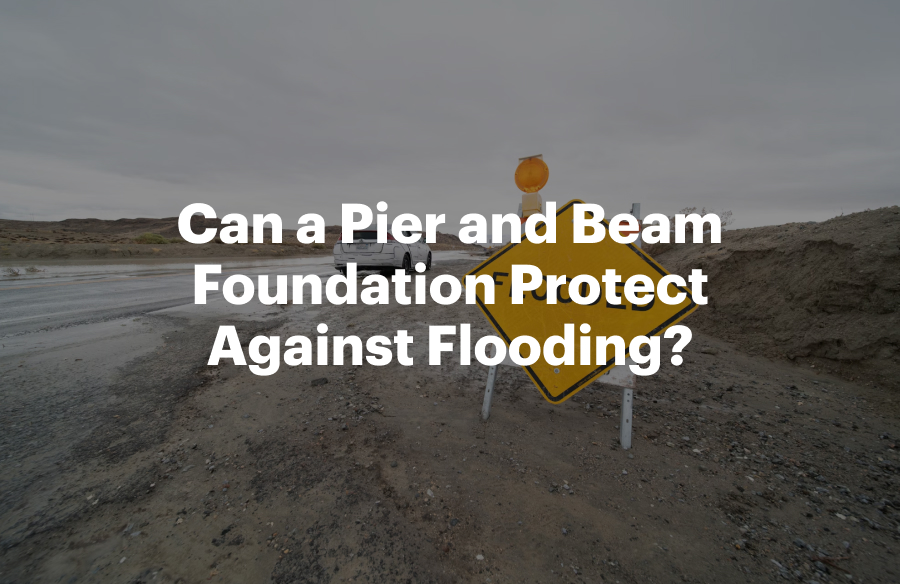Home foundation types each have their strengths and weaknesses depending on the soil, climate, and terrain. In Fort Worth and Dallas, weather can cause flash flooding, and homeowners often wonder if a pier and beam foundation can offer added protection against water-related damage. In this blog, we’ll explore the relationship between pier and beam foundations and flood resistance, what benefits they offer in these wet conditions, and what homeowners need to look out for, because elevated homes aren’t completely immune to flood-related damage.
What Is a Pier and Beam Foundation?
A pier and beam foundation is a system where concrete or wooden piers are dug or hammered into the ground, supporting wooden or steel beams that hold up the home. Most residential homes use wood. This creates a small area underneath the house called a crawl space, typically 18 to 36 inches high, which allows for easy access to the utilities of a home like plumbing, electrical, and AC vents.
These are different from slab foundations that sit directly on the ground, pier and beam homes are elevated. This makes them a good option if you live in an area prone to moisture, pooling water, or poor drainage.
Does Elevation Help Prevent Flooding?
Yes, but it is not its intended purpose. One of the biggest advantages of a pier and beam foundation is its increased height. It provides a space between a home’s floor and the ground. This means that if a heavy rainstorm or flash flood water builds up it is less likely to enter the interior of the home.
Here’s how that helps:
- Water runoff is less likely to reach the floor level of your home.
- Plumbing and wiring located in the crawl space are easier to inspect and repair if water intrusion does occur.
Fort Worth or Dallas have a lower elevation and have drainage challenges. This elevation can offer real peace of mind, during the rainy season. The soil can become oversaturated and stormwater accumulates quickly.
What Are the Limitations?
While a pier and beam foundation can reduce the risk of flood damage, it’s not a guaranteed shield against all water-related damage. In Fort Worth, homes have vulnerabilities to be aware of:
1. Crawl Space Flooding
If water levels rise high enough, it can still enter the crawl space beneath the home. Water can cause damage to your home’s utilities. Additionally there is an increased risk of mold growth, wood rot, and pests if not dealt with.
2. Moisture and Humidity
Even without flooding, moisture in the crawl space from rainy periods or poor drainage can cause damage to the wooden beams or subfloor.
3. Poor Ventilation
Older pier and beam homes may not be sealed or ventilated properly, allowing moisture under the house. Inconsistent airflow or blocked vents can turn a crawl space into an ideal climate for mold and mildew.
How to Maximize Flood Protection for Pier and Beam Foundations
If you already have a pier and beam foundation, or are considering buying a home with one, it’s important to take preventive measures to maximize its flood resistance:
- Install a sump pump in the crawl space to automatically remove water during storms.
- Seal and insulate the crawl space to reduce humidity and moisture intrusion.
- Check for proper grading around the home so rainwater flows away from the foundation.
- Add flood vents or air vents to allow for better air circulation and minimize pressure from rising water.
- Regularly inspect and maintain drainage systems, including gutters, downspouts, and French drains, to ensure water is moving away from the house.
When to Consider an Inspection
If you’ve noticed signs of water damage under your home, like soft or sagging floors, musty smells, or visible water in the crawl space, it may be time to have a professional inspection. At Maestro’s Foundation Repair, we specialize in evaluating pier and beam homes in Fort Worth and Dallas, including water drainage issues that could put your home at risk.
No foundation is 100% flood-proof, but pier and beam homes do offer distinct advantages when it comes to minimizing water damage. Their elevation provides a level of protection that slab foundations can’t. In regions like North Texas, heavy rains can hit hard and fast. However, proper maintenance and preventative care are key to ensuring that the foundation continues to do its job. With the right attention, a pier and beam foundation can be both flood-resilient and long-lasting.
